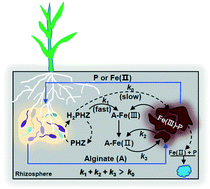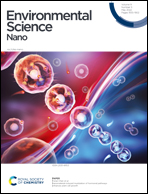Alginate promotes soil phosphorus solubilization synergistically with redox-active antibiotics through Fe(iii) reduction†
Abstract
Redox-active antibiotics have been recently found to enhance phosphorus (P) bioavailability through reductive dissolution of Fe(III) oxides and solubilization of adsorbed P. However, there has been a lack of quantitative insights into their effect on Fe(III)–P minerals in natural environments with extracellular polymeric substances (EPS). Here, by taking phenazine (PHZ) antibiotics for a case study, we quantified the Fe(II) production and P solubilization with batch reduction experiments and in situ reductive dissolution kinetics of Fe(III)–P (amorphous and crystalline phases) by the liquid-cell atomic force microscopy (AFM) technique. Firstly, we captured the differences in the amount of Fe(II) production and P solubilization after exposure to different reduced PHZ-bearing buffer solutions under simulated environmental conditions, which were further confirmed by the nanoscale surface dissolution as indicated by the formation of etch pits. In addition, Fe speciation analysis and content measurement clearly showed enhanced Fe(III) reduction in the presence of a binary combination of alginate and H2PHZ, independent of the types of H2PHZ and Fe(III)–P species. Similarly, an increase in the concentration or polymerization degree of alginate promoted the dissolution rate of Fe(III)–P compared with the controls. By providing Fe(III) in a soluble organic form, the alginate–Fe(III)/H2PHZ in solution could significantly facilitate the redox reaction process relative to solid-phase Fe(III)/H2PHZ and/or free Fe(III)/H2PHZ, resulting in alginate-promoted reduction of solid-phase Fe(III) and solubilization of co-precipitated P. These results indicate a widespread but previously ignored role of EPS coupled with redox-active antibiotics in expanding the bioavailable pools of Fe(II) and P. We also suggest that similar studies of ligand-enhanced microbial redox of Fe-bearing minerals may reveal how ligands and microbes collectively control the redox process to affect the biogeochemical cycling of Fe and P, and thus the eventual nutrient management for agronomical and environmental sustainability.

- This article is part of the themed collection: Environmental Science: Nano Recent HOT Articles


 Please wait while we load your content...
Please wait while we load your content...